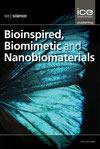kartogenin/PLGA纳米颗粒对丝支架性能和干细胞命运的影响
IF 0.6
4区 工程技术
Q4 ENGINEERING, BIOMEDICAL
引用次数: 0
摘要
软骨是一种无血管和神经结缔组织,自我修复能力较差。最近,组织工程学为避免或治疗软骨损伤开辟了新的视野。在这项工作中,kartogenin (KGN)是一种小的软骨诱导分子,被装载到聚乳酸-羟基乙酸(PLGA)纳米颗粒(NPs)中,然后被嵌入到丝素(SF)支架中,为间充质干细胞(MSC)分化准备一个合适的微环境。在本研究中,我们选择了SF作为支架材料,因为它具有良好的生物相容性和无毒性,以及优异的机械性能和可加工性。本研究获得的数据表明,在NPs中包埋KGN具有缓释作用,可促进MSCs向软骨细胞分化。同样,含有负载kgn的NPs的支架诱导种子间质干细胞产生糖胺聚糖。同时,在支架中加入NPs可以提高结构的抗压强度(两倍以上),但对其膨胀行为没有显著影响。综上所述,作者的研究结果表明,所制备的支架具有最佳结构,可能是软骨组织再生的潜在候选材料。本文章由计算机程序翻译,如有差异,请以英文原文为准。
Effects of kartogenin/PLGA nanoparticles on silk scaffold properties and stem cell fate
Cartilage is an avascular and aneural connective tissue with poor self-healing capability. Recently, tissue engineering opens up new horizons for staving off or treating cartilage lesions. In this work, kartogenin (KGN), a small chondro-inductive molecule, was loaded into poly(lactic-co-glycolic acid) (PLGA) nanoparticles (NPs), which in turn was embedded in a silk fibroin (SF) scaffold, to prepare an appropriate microenvironment for mesenchymal stem cell (MSC) differentiation. In this research, SF was opted to serve as a scaffold based on its approved biocompatibility and non-toxicity, excellent mechanical properties and processability. The data obtained from this study show that entrapment of KGN in NPs provides sustained release, which could promote the differentiation of MSCs into chondrocytes. Likewise, the scaffold containing KGN-loaded NPs induces glycosaminoglycan production by the seeded MSCs. The introduction of NPs into the scaffold, meanwhile, elevated the compressive strength of the structures (more than two times) without any significant effect on their swelling behavior. Taken together, the authors’ findings demonstrate that the prepared scaffold, with an optimal structure, could be a potential candidate for cartilage tissue regeneration.
求助全文
通过发布文献求助,成功后即可免费获取论文全文。
去求助
来源期刊

Bioinspired Biomimetic and Nanobiomaterials
ENGINEERING, BIOMEDICAL-MATERIALS SCIENCE, BIOMATERIALS
CiteScore
2.20
自引率
0.00%
发文量
12
期刊介绍:
Bioinspired, biomimetic and nanobiomaterials are emerging as the most promising area of research within the area of biological materials science and engineering. The technological significance of this area is immense for applications as diverse as tissue engineering and drug delivery biosystems to biomimicked sensors and optical devices.
Bioinspired, Biomimetic and Nanobiomaterials provides a unique scholarly forum for discussion and reporting of structure sensitive functional properties of nature inspired materials.
 求助内容:
求助内容: 应助结果提醒方式:
应助结果提醒方式:


